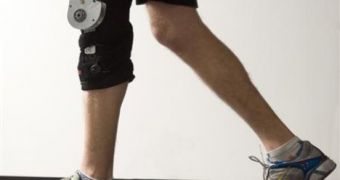The challenges brought first by the 21st century are thoroughly related to the amounts of energy humankind consumes. With numerous power plants coming on-line every week, most of which are powered by coal, the energy output increases, while, at the same time, polluting the environment around each of us. It's pretty clear by now that energy shortages will be our most pressing concern over the next decades, as fossil fuels disappear and renewables still struggle to take their place.
This reasoning made Simon Fraser University kinesiologist Max Donelan decide to do something about it and so he went on to invent the Bionic Energy Harvester, a biomechanical device that uses human walking as a source of "fuel." The device is worn on the knee and two of them, worn on both feet, can quickly generate about 5 watts of electrical energy, enough to charge 10-cell phones.
The operating principle behind this invention is a concept similar to the one electrical cars use to recycle the energy around them. When these cars break, the kinetic energy that is put out by the stop is re-captured and transformed back into electrical energy. A similar application uses the energy our ligaments put out for stopping the legs at the end of each step.
While the device is still years away from potential commercial use, it's already regarded as one of the best inventions in this field. Harvesting electrical energy from daily activities is a long-standing goal for researchers, as evidenced by multiple studies, including harnessing the power of footsteps on the sidewalk.
After it's widely-distributed, the Bionic Energy Harvester could be used to power up gadgets, such as mp3 players, phones and radios, and will be extremely useful in emergency situations, when all other electricity sources are unavailable. Rescue workers could also benefit from it if their victims, trapped under rubble, have such a device and a radio or cell phone with them.

 14 DAY TRIAL //
14 DAY TRIAL //